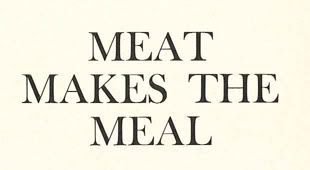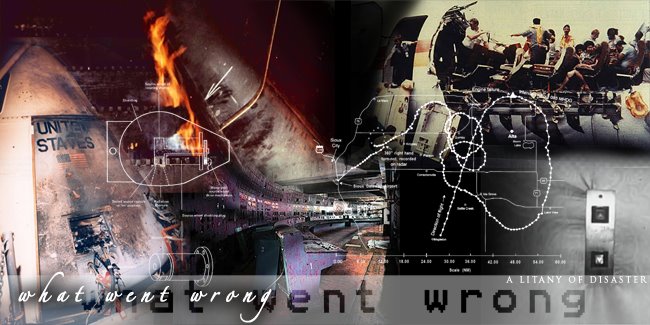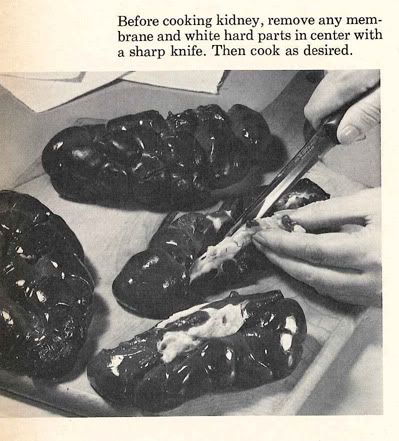
It had its own Cook Book.
But meat wasn't just limited to vast glistening centerpiece roasts. Meat could appear in many creative guises, such as Dilly Beef Cartwheel, Stuffed Pork Chops, Orange-Glazed Escarpments, Steak with Maggot Garnish (always serve with white zinfandel in an Erlenmeyer flask), Masked Identity Meat in Popovers, and Meatballs Attempting to Escape.
Meat dishes from this period can be roughly grouped into several categories: Meat that has been Ground and Shaped Into Masses, Meat that Maintains its Original Muscle Integrity, and Meat that Somebody Else has Already Processed. The variety of meatloaves and meatballs (meat loaves and meat balls, which sounds thirty times less appetizing) available in your standard Avocado Green and Harvest Gold kitchen would be categorized as Ground and Shaped Into Masses, as would leftover meat that has been chopped up and added to a jellied salad or vinyl sauce. Roasts and most hams, chops, and steaks would fall under the Original Muscle Integrity category, at least until the housewife cut holes in them and started stuffing cubes of Velveeta and canned pineapple inside. Meat that Somebody Else has Already Processed covers sausage of all descriptions, Spam and its forlorn competitors (Mor, Treet, Prem, Temt, Bif, etc), and canned ham.
Luckily for everyone, I've got examples of all three!
We'll begin with Mock Pot Roast, which is frankly sad. "Everyone squint, and I'll turn down the lights, and maybe if you wish real hard it'll taste like pot roast instead of a giant lump of ground beef, oats, and bottled gravy coloring!" The caption states that this is a "stunning" meat loaf in a dish. I suppose you could place the whole thing inside a sack and swing it at people's heads to stun them. I suppose.
Then we have Duchess Meat Loaf Pie, which is creative because it's a meat loaf in a skillet with instant mash on top and because it comes pre-infested with maggots.
The cook who is using ground meat may find herself faced with the difficult decision of whether to shape the flesh into a loaf or a ring. (Or a cube, or a cone, or a cowpat?) If she chooses the ring, she must fill the hole in the middle with enough green-flecked rice to support a selection of gleaming black shuttlecocks. If the loaf is selected, it must be topped with a miniature limp green octopus. Note the recipe for the "Piquant Ring" contains half a cup firmly packed brown sugar and a quarter-cup each of orange juice and molasses. Dentists must have loved the 70s.
Here we have semiconscious cow heads adorning round hamburgers and vinyl sauce (vinyl cheese, in this case) covering Wendy's-style square burgers. Note the use of what appear to be surgical pins to anchor the olives and tomatoes to the vinyl cheese.
Sometimes the housewife wanted to hide her shame and wrap up the ground meat inside a cabbage leaf. This never ended well.
Maggots are a recurring theme in the Great Book of Hamburger, as evidenced by Spanish Mince and Maggot Roll. Can you spot the worm head in this picture?
But nothing compares to this presentation: none of these ground-up gustatory delights can hold a candle to the following image:
Rapier-Pierced Bowel Movements in Ill-Fitting Buns.
That's quite enough of that. Let's move on to Meat that Retains its Original Muscle Integrity, with Sugared Pork Snout Roast. Doesn't that look amazing? Spiced pears, even!
Braising in bleach was one of the ways cooks in the 70s made sure their meals were free of illness-causing bacteria.
Here we have the fabled Death Valley Dead Thing Rôti. This must be cooked over a pale flame on rippled sand just as the sun peeps above a distant mountain range. Otherwise the skinwalkers will find you.
You think I'm kidding about the vinyl sauce thing? They came right out and said it: this unappealing pot roast is draped in a rich brown gravy. You don't drape gravy. You drape vinyl.
We've seen this before, but here's the pink petal posy ham à la sandworm head. Glazing of pig products with various viscous sugary syrups seems to have been not so much a fashion as an enforceable law: some creative individuals took advantage of the opportunity to glue things onto the side of their glazed pig chunks in the process of covering them in sugar. Somewhere out there on the internet there is a picture of a leg of something with a paddleboat design stuck onto it, made out of wheels of lemon. More about sugar and pig in future posts.
What of the third group, the Pre-Processed Meats? Well, the Meat Cook Book is diligent in explaining the various sorts of sausage known to man.
As many of you already know, the frankfurter was given a more classy and haute-cuisine sort of role in the sixties and seventies. Phrases like "frankfurter spectacular" and "Franks take on a new glamor in this gleaming aspic" now strike dread into the heart of the reader, but at the time we must imagine they were really considered to be more than just mechanically separated meat slurry spiked with nitrates. Take for example Frank Corn Crown, described as "fancy," or Glazed Apples 'n Franks. Gleaming, is what those are. Gleaming with sugar and preservatives.
Sausage could be possessive. You didn't want to get between a loop of kielbasa and its mustard pot.
Sometimes sausages were relegated to the role of garnish, but even so they were carefully prepared for their close-ups, some being given a golden spray tan and some remaining pallid and delicate grey-pink.
Sausage could also be brown.
And finally, pathetically, we come to Tangy Potato Salad, which consists of chunks of hot dog and potato mixed up with cream of celery soup. This, like several of the other dishes in today's post, is from the Better Homes and Gardens "Good Food on a Budget" cookbook, which offers the struggling housewife a variety of tips for "stretching" the food budget, including the use of variety meats and sating the heartier appetites with bread. "Good Food on a Budget" is less lurid and hallucinogenic than some of the earlier BHaG tomes, but it's a lot more depressing.
So have a Bacon Big Boy to cheer you up, and remember: MEAT MAKES THE MEAL.
I'm not making this up.








